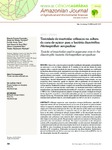Por favor, use este identificador para citar o enlazar este ítem:
http://www.alice.cnptia.embrapa.br/alice/handle/doc/940453Registro completo de metadatos
| Campo DC | Valor | Lengua/Idioma |
|---|---|---|
| dc.contributor.author | FERNANDES, M. F. | pt_BR |
| dc.contributor.author | PROCOPIO, S. de O. | pt_BR |
| dc.contributor.author | TELES, D. A. | pt_BR |
| dc.contributor.author | SENA FILHO, J. G. de | pt_BR |
| dc.contributor.author | CARGNELUTTI FILHO, A. | pt_BR |
| dc.contributor.author | MACHADO, T. N. | pt_BR |
| dc.date.accessioned | 2012-11-23T11:11:11Z | pt_BR |
| dc.date.available | 2012-11-23T11:11:11Z | pt_BR |
| dc.date.created | 2012-11-23 | pt_BR |
| dc.date.issued | 2012 | pt_BR |
| dc.identifier.citation | Revista de Ciências Agrárias, Belém, v. 55, n. 4, p. 318-326, out./dez. 2012. | pt_BR |
| dc.identifier.uri | http://www.alice.cnptia.embrapa.br/alice/handle/doc/940453 | pt_BR |
| dc.description | RESUMO: Apesar de a cana-de-açúcar responder à adubação nitrogenada, principalmente na cana-soca, o uso de fontes minerais de N constitui-se em um dos fatores de maior impacto sobre o custo de produção da cana-de-açúcar. Estudos apontam que a utilização de bactérias diazotróficas pode suprir parte da necessidade de nitrogênio da cana-de-açúcar. Objetivou?se, neste trabalho, identificar inseticidas utilizados na cultura da cana-de-açúcar que não afetam o crescimento ? ou não causam prejuízos à capacidade de fixação biológica de nitrogênio (FBN) ? da bactéria diazotrófica Herbaspirillum seropedicae. Cinco inseticidas (imidacloprid, fipronil, thiamethoxam, endosulfan e carbofuran) foram testados, em suas respectivas doses comerciais, quanto ao impacto sobre os parâmetros de crescimento da bactéria. Os parâmetros analisados foram duração da fase lag, tempo de geração e densidade celular máxima. Também foi avaliado o impacto dos inseticidas na atividade da nitrogenase de H. seropedicae cultivada em meio semissólido. Os inseticidas endosulfan e carbofuran prejudicaram o crescimento da bactéria diazotrófica H. seropedicae, contudo não reduziram a FBN in vitro. Carbofuran promoveu aumento no tempo de geração e redução na duração da fase lag de H. seropedicae; o inseticida endosulfan, por sua vez, ocasionou aumento na duração da fase lag. Os inseticidas imidacloprid, fipronil e thiamethoxam não ocasionaram nenhum efeito deletério tanto no crescimento quanto ao FBN in vitro de H. seropedicae. ABSTRACT: Toxicity of insecticides used in sugarcane crop to the diazotrophic bacteria Herbaspirillum seropedicae. Although sugarcane crop responds to nitrogen fertilization, especially in sugarcane ratoon, the use of mineral sources of N is one of the factors of great economic impact in sugarcane production. Studies indicate that the use of diazotrophic bacteria can supply part of the need of nitrogen for this crop. The objective of this study was to identify pesticides used in the cultivation of sugarcane that do not affect the growth or cause harm to the ability of biological nitrogen fixation (BNF) of the diazotrophic bacterium Herbaspirillum seropedicae. Five insecticides (imidacloprid, fipronil, thiamethoxam, endosulfan and carbofuran) were tested in their respective commercial doses regarding their impact on bacteria growth. The parameters analyzed were duration of the lag phase, generation time and maximum cell density. The impact of pesticides on the nitrogenase activity of H. seropedicae grown in semi-solid medium was also assessed. Endosulfan and carbofuran hindered the growth of diazotrophic bacteria H. seropedicae, but did not reduce the BNF in vitro. Carbofuran increased the generation time and reduced the lag phase duration of H. seropedicae. Endosulfan increased its lag phase duration. Imidacloprid, fipronil and thiamethoxam did not cause any toxic effects to the growth and BNF in vitro of the diazotrophic bacteria H. seropedicae. | pt_BR |
| dc.language.iso | por | pt_BR |
| dc.rights | openAccess | pt_BR |
| dc.subject | Cana-de-açúcar | pt_BR |
| dc.title | Toxicidade de inseticidas utilizados na cultura da cana-de-açúcar para a bactéria diazotrófica Herbaspirillum seropedicae. | pt_BR |
| dc.type | Artigo de periódico | pt_BR |
| dc.date.updated | 2013-08-20T11:11:11Z | pt_BR |
| dc.subject.thesagro | Fixação de nitrogênio | pt_BR |
| dc.subject.thesagro | Inseticida | pt_BR |
| dc.subject.nalthesaurus | Sugarcane | pt_BR |
| dc.subject.nalthesaurus | Nitrogen fixation | pt_BR |
| riaa.ainfo.id | 940453 | pt_BR |
| riaa.ainfo.lastupdate | 2013-08-20 | pt_BR |
| dc.identifier.doi | 10.4322/rca.2012.077 | pt_BR |
| dc.contributor.institution | MARCELO FERREIRA FERNANDES, CPATC; SERGIO DE OLIVEIRA PROCOPIO, CNPSO; DANIELE ARAÚJO TELES, UNIVERSIDADE FEDERAL DE SERGIPE; JOSE GUEDES DE SENA FILHO, CPATC; ALBERTO CARGNELUTTI FILHO, UFSM; THADEU NASCIMENTO MACHADO, UFS. | pt_BR |
| Aparece en las colecciones: | Artigo em periódico indexado (CNPSO)  | |
Ficheros en este ítem:
| Fichero | Descripción | Tamaño | Formato | |
|---|---|---|---|---|
| toxicidade.rev.cienc.agra.procopio.pdf | 906,53 kB | Adobe PDF |  Visualizar/Abrir |









